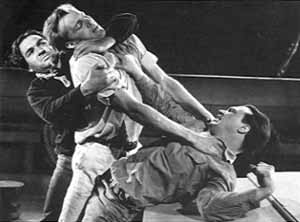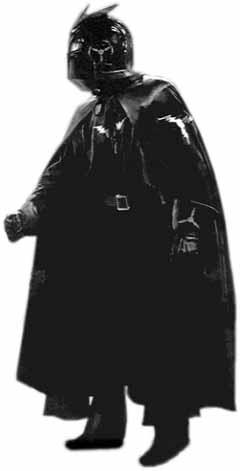|

Herman Brix struggles on board a ship
in The Fighting Devil Dogs.
As the title of this serial implies, the Lightning battles the U.S. Marines. Lee Powell and Herman Brix play the heroes. Chapter One gets off to a chilling start as Powell and Brix tramp through the jungles of Lingchuria and discover an entire platoon has been wiped out. "Hey! What is this? What's killing these people?" Even flies lay dead on the ground. It's a truly spooky start to Fighting Devil Dogs and one of the most atmospheric, chilling pieces of filmmaking you'll find in the history of the serial.
See The Lightning use his lightning gun,
an excerpt from The Fighting Devil Dogs.
(Animated GIF, 25 frames, 150 KB)
With directors William Witney and John English in control, Fighting Devil Dogs moves at a breakneck pace from the jungles of Lingchuria to San Francisco to South Sea islands, as Powell and Brix struggle to undermine the Lightning's plans and learn his true identity. But the Lighting always keeps two steps ahead of them. An informer contacts Powell and says "I have certain papers that the United States government must see. A fiend is behind a monstrous plot to control whole nations. What happened in Lingchuria is but a small demonstration of his powers." And then the Lightning promptly steps from shadows and zaps the informer with his thunderbolt pistol.
Herman Brix actually plays second banana in this serial. Lee Powell gets all the best scenes and all the cliffhangers revolve around Powell. Republic clearly intended Powell to become one of their top serial stars (he also starred in The Lone Ranger), but Powell enlisted in the military during World War II and he was killed in the Pacific. So we'll never know just how large his star could have grown. In Fighting Devil Dogs, however, he gives a strong, charismatic performance. The script also adds more personal anguish to the mix as the Lightning kills Powell's father, leaving Powell on a vendetta to bring the killer to justice.
The Lightning flaunts his true identity: "I am never suspected. I move amongst those most anxious to find me out. The fools! Perhaps they think I am too unimportant for them to suspect. No one will ever learn the identity of the Lightning!"

The Lighting and his head henchman menace
a female victim in The Fighting Devil Dogs.
Fighting Devil Dogs is the second least expensive serial produced by Republic. Budgeted at $94,656 and finished for just $92,569, Fighting Devil Dogs shows its low budget in several ways--such as the extensive recycling of footage from previous Republic serials and the use of two (count 'em two!) retrospective chapters that did little but summarize the previous chapters. The flying wing comes from Dick Tracy, as does a tense chapter ending where two navy ships put the squeeze on a speedboat. But the cost-cutting measures are hardly noticeable amidst the plethora of action sequences. Fighting Devil Dogs moves through an astonishing variety of scenes. In addition to the aforementioned scenes of the Marines hacking their way through the jungle underbrush of Lingchuria, we get the boys fighting underwater, on ships, in airplanes, in submarines, and in caves. In addition, they pursue some quieter investigations in the scientific laboratory. Powell and Brix aren't just lunkhead muscle boys: they understand the value of science as well. At one point, they take ashes back to the laboratory to be inspected under an infra-red camera--in an effort to discover what was originally written on the paper. But when the situation requires some athleticism, the boys are more than capable. They climb ropes and leap through windows like Douglas Fairbanks. But Fighting Devil Dogs isn't like the Republic serials of the late '50s, which frequently degenerate into fist fight marathons. Directors Witney and English occasionally give us a slugging match, but they usually supply a wide variety of action sequences.
When George Lucas created Star Wars, he actually managed to improve on the villain. Whereas the Lightning was simply an ordinary-sized guy under the helmet and cape, Darth Vader took the form of the towering David Prowse, who stood nearly a head taller than the other actors. And instead of the nasally whine of the Lightning, we got the booming sonorous voice of James Earl Jones.
However, in the short history of the serials, few villains could match the Lightning. Unlike so many serial villains who became little more than underworld kingpins with armies of dunderhead henchmen, the Lightning was a truly scary creation who actually looked like he could make good on his quest to conquer the world--if not for those pesky Marines!
The Serials: An Introduction
Page 1: In the Theaters
Page 2: The Beginnings
Page 3: Enter Flash Gordon
Page 4: The Golden Age
Page 5: The Downfall
The Phantom Empire
Flash Gordon
Dick Tracy
The Fighting Devil Dogs
Zorro's Fighting Legion
The Shadow
Mysterious Dr. Satan
Spy Smasher
Perils of Nyoka
The Tiger Woman
Serials Web Links
|


 Evil villains filled the serials. The Crimson Ghost, the Scorpion, the Spider, and the Dragon menaced our heroes week after week with diabolical devices such as the radiatomic transmitter, the decimator, and the cyclotrode.
Evil villains filled the serials. The Crimson Ghost, the Scorpion, the Spider, and the Dragon menaced our heroes week after week with diabolical devices such as the radiatomic transmitter, the decimator, and the cyclotrode.


